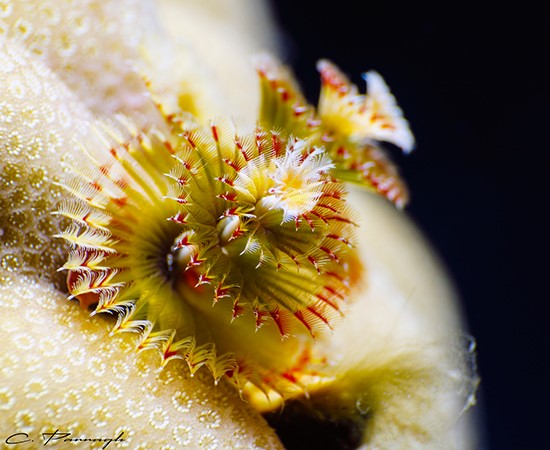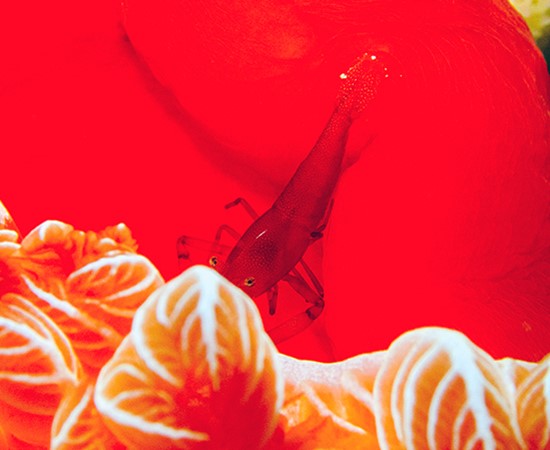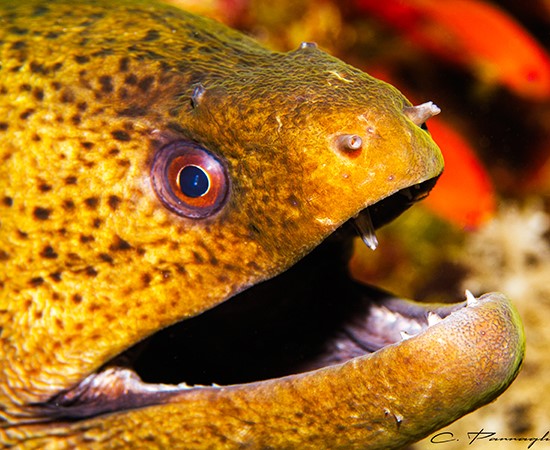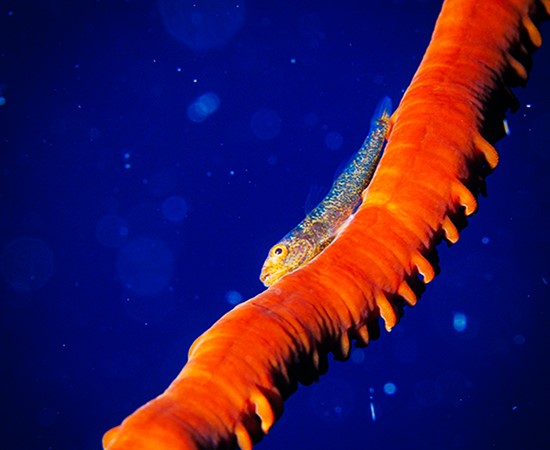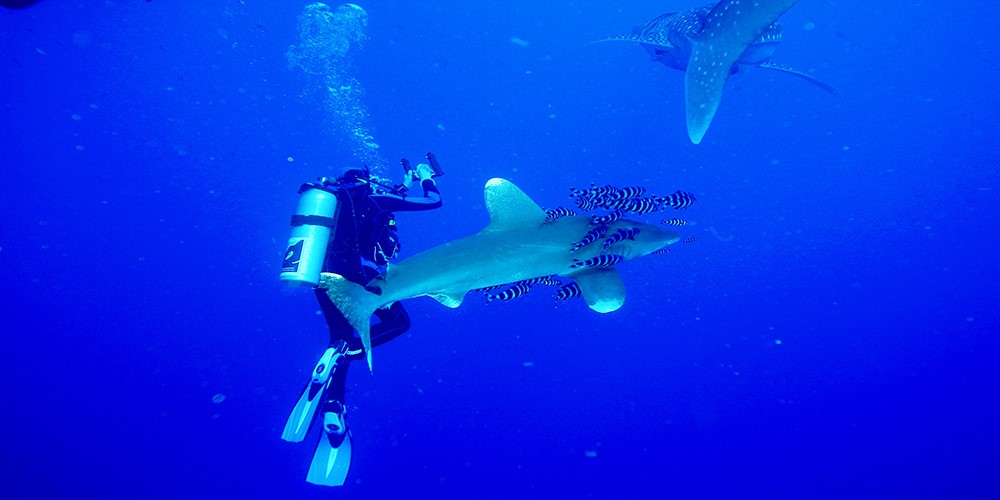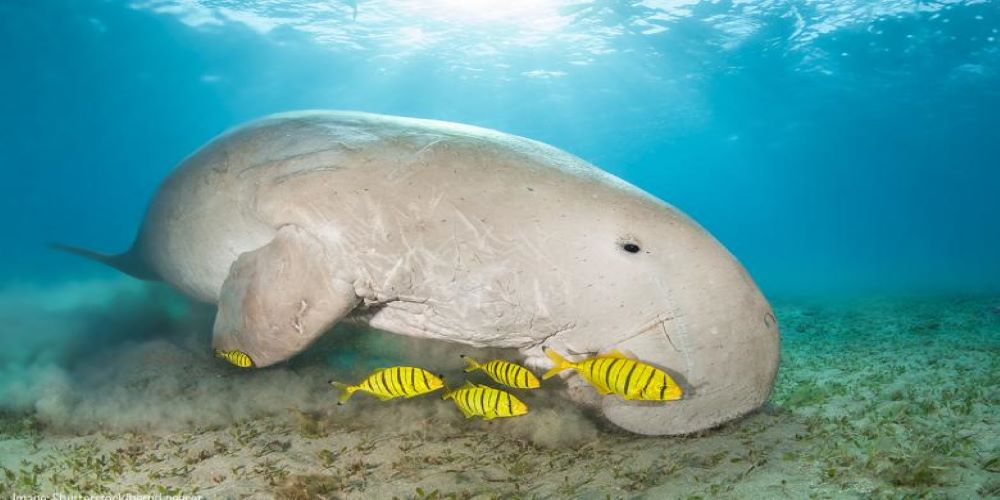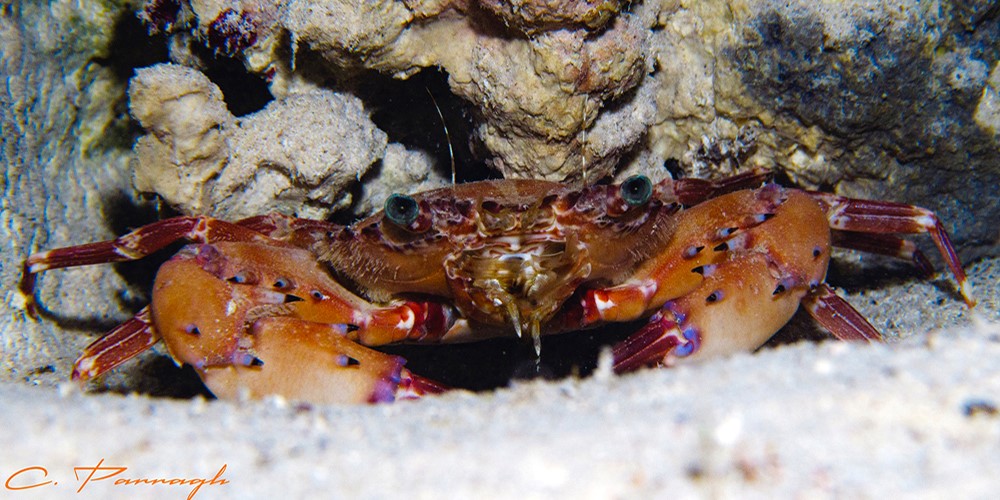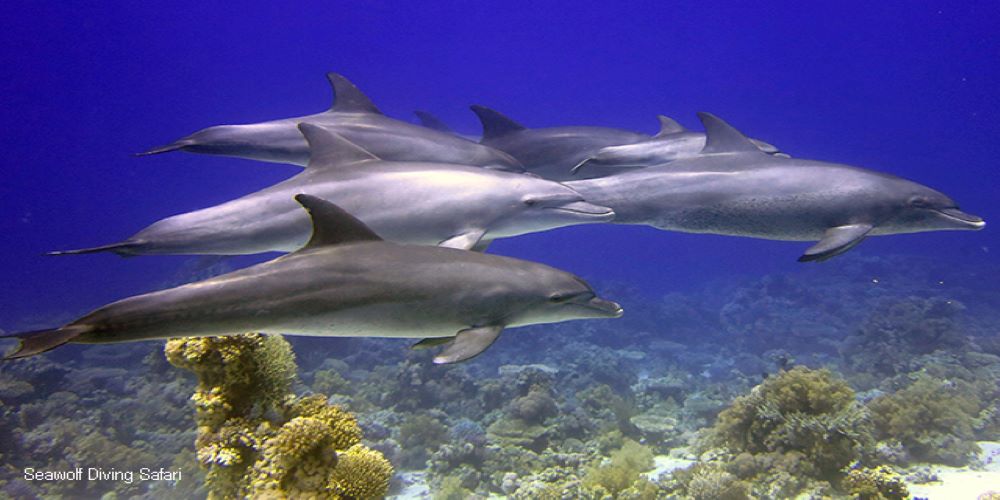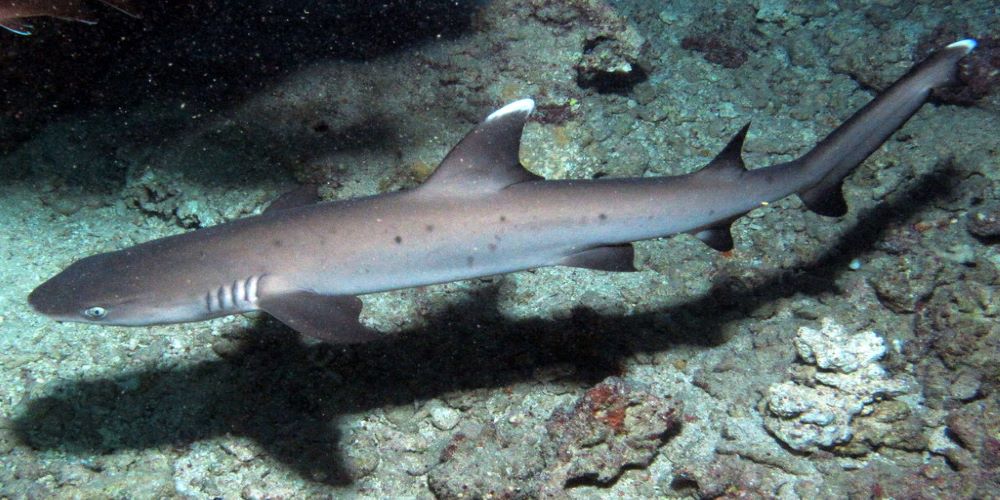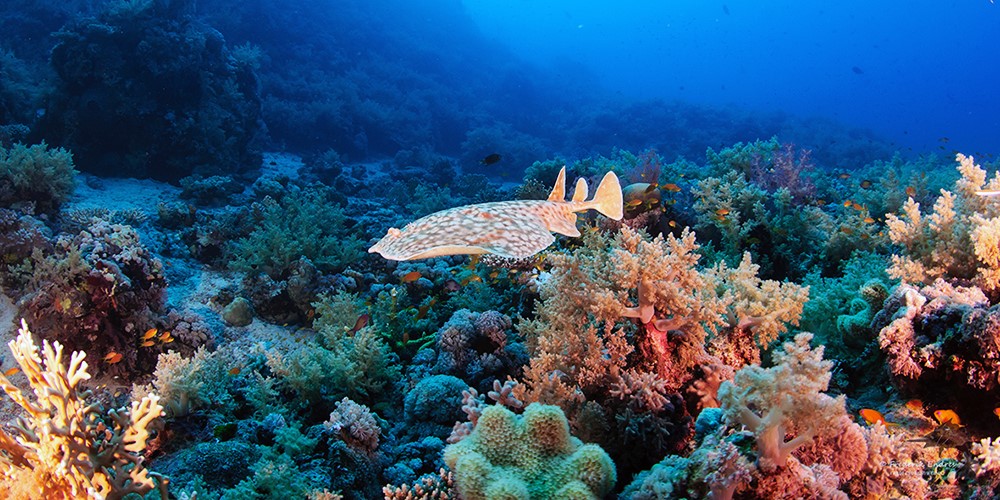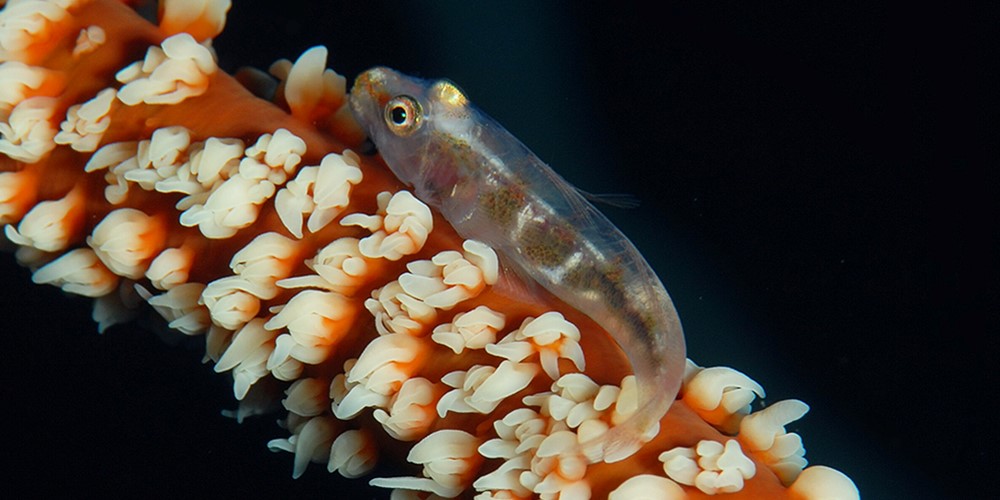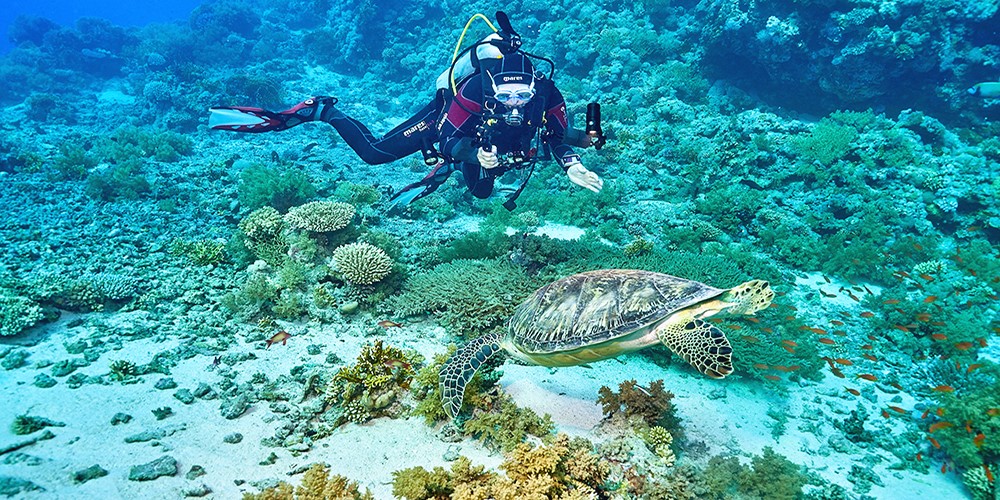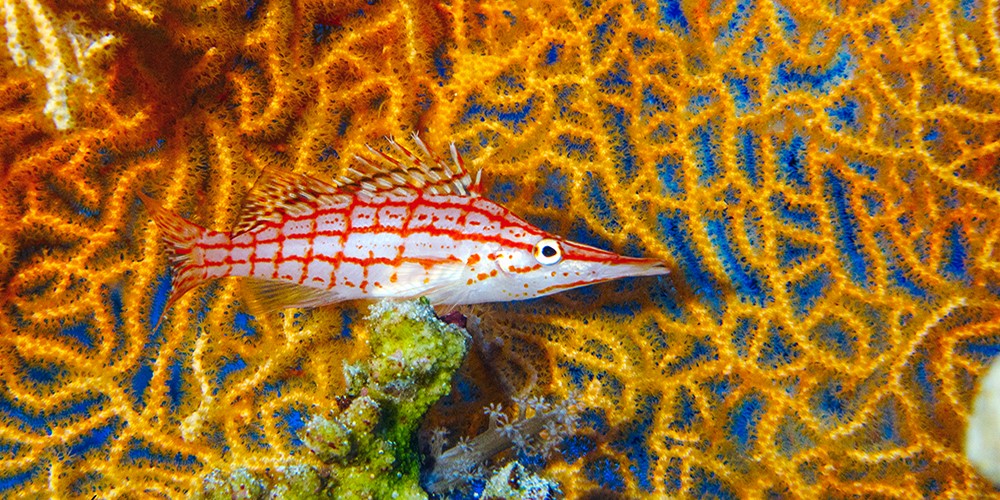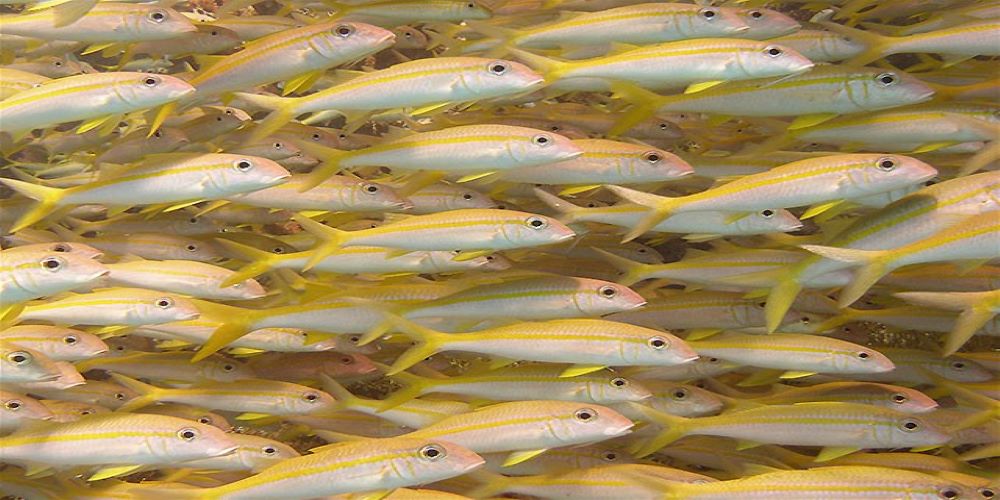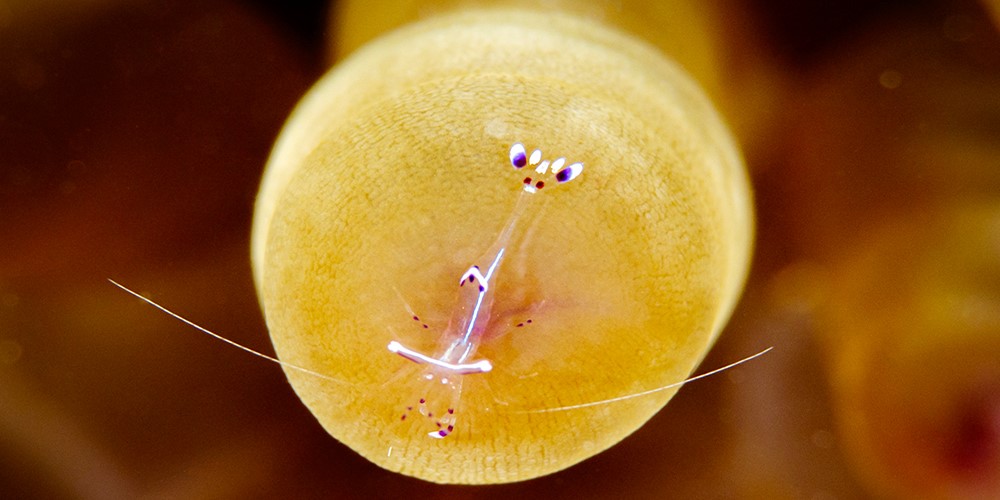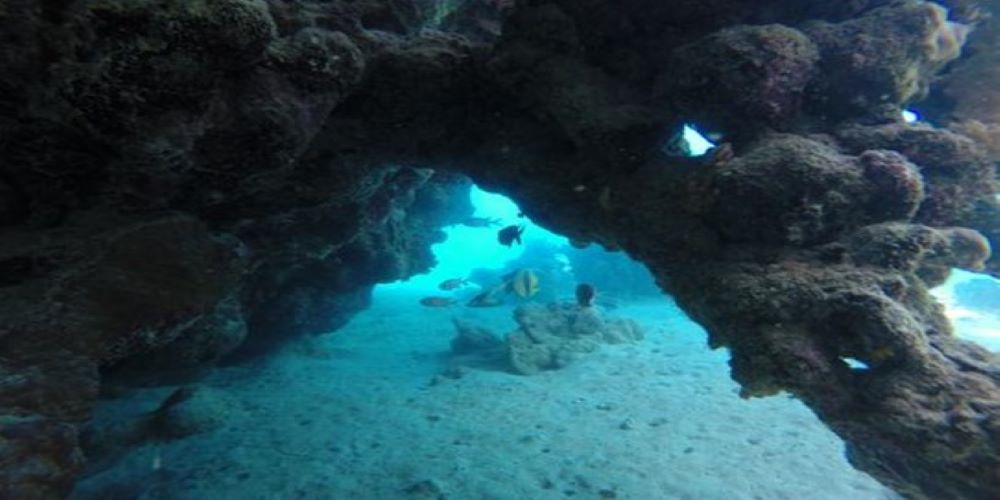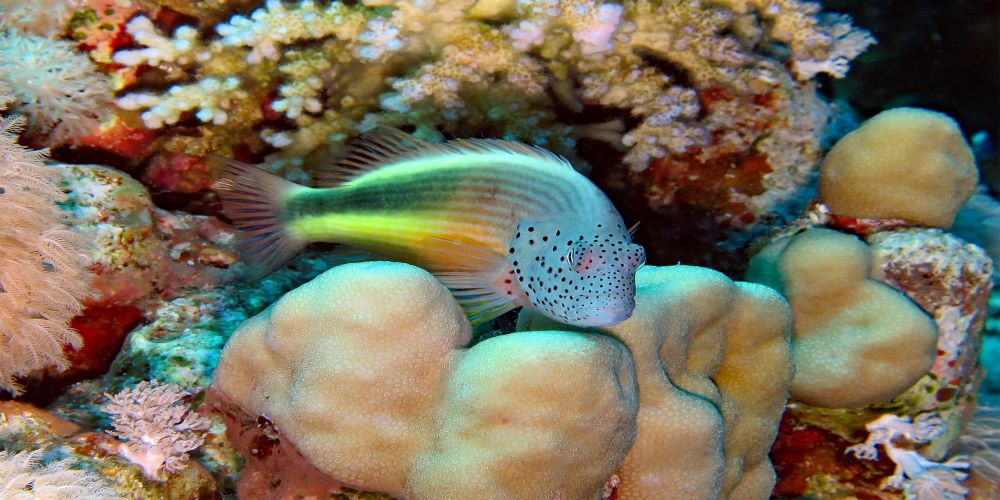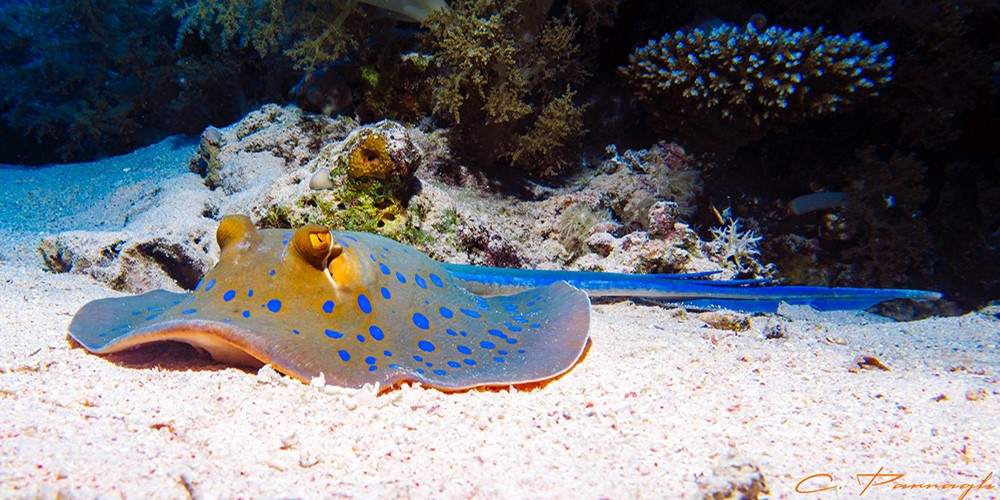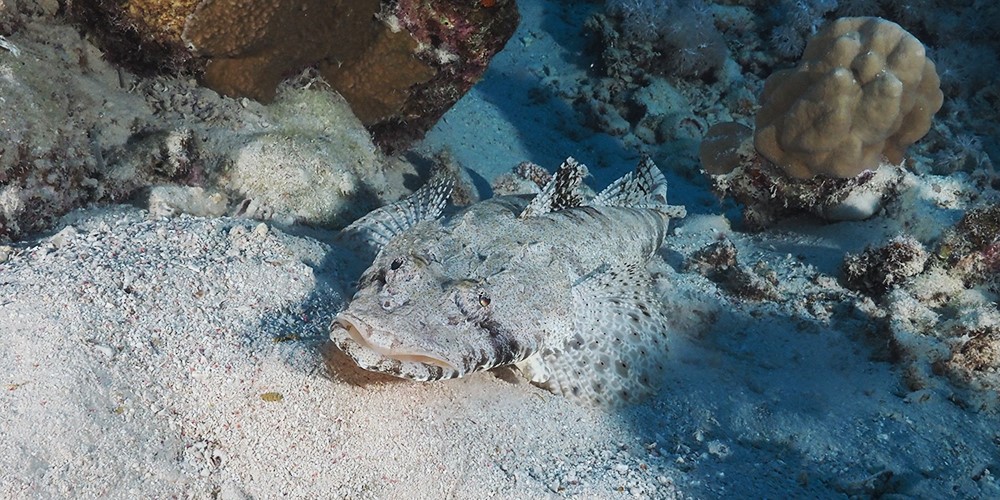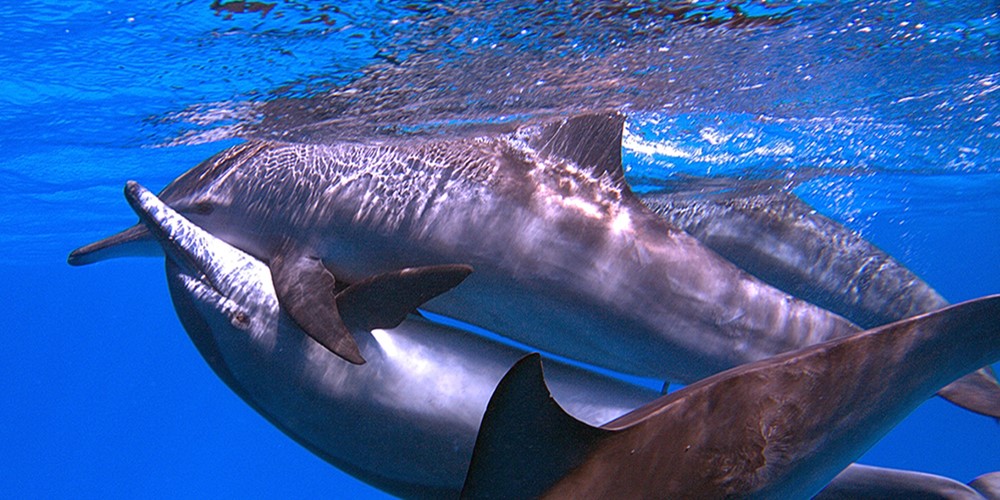Abu Fendera 11 days
- Abu Fendera area is located near the border of Egypt with Sudan. It is possible to do this tour within one week. However, this means a stay of 3 dives in Abu Fendera.
- Therefore we recommend 10 days or even a 2 week tour in this area. Deep into the south our trip should go by boat, there, where there is not yet a "mass of divers". Where it is something special to dive at the reefs, where there is a colorfulness and a richness of fish, as you rarely see.
- The main reef is about 6 km long. Explorers will find a huge area with beautiful coral landscape. The attraction of this reef is, among other things, its lonely location - sometimes you will not meet another boat for several days.
- The main reef cannot be called spectacular. However, the "passage" between the reefs is a gem. In front of the reef there are numerous coral blocks, overgrown by beautiful soft corals. At these dive sites you can very often meet humphead wrasse in all sizes. Very impressive are also large schools of bumphead parrotfish and the sighting of a sailfish can take your breath away.
Expect to see
Elphinstone
From Marsa Alam the boat goes about one and a half hours north to Elphinstone Reef! The reef top of Elphinstone Reef lies at a depth of between one and three meters, depending on the water level. Strong surface currents and lots of boat traffic make snorkeling here impossible.
Divers, however, can dive right into a challenging treat! The reef is known for its exceptional biodiversity and, of course, sightings of large fish. In the north we dive on a sloping plateau from 18 to 40 meters and in the south on the underwater terraces. The west and east walls drop off steeply into the depths. The Elphinstone reef has a total length of about 600 meters and a width of 70 meters.
In large numbers we can see hard and soft corals in all colors. In addition, there are turtles, moray eels, loceanic white tip sharks, hammerhead sharks and pretty much everything that the Red Sea has to offer.
Shaab Shona
The lagoon is formed from a dried up river (wadi) and with a diameter of 150m between 5 and 45m deep. You can still see the wadi in the middle as a channel that rises to the north and south. In the north there is a plateau whose edges drop from 14 to over 40m.
The north side is characterized by boulders where you can find ghost pipefish, long-jawed makerels, glassfish and crocodile fish, but of course also as many different coral species. They reach from the reef edge partly down to 20m and are covered with life.
Dangarus Reef
This is the southernmost reef of St. John's and offers plenty of variety. The reef has an extension of 150m by 70m. Hidden on the main reef is the small cave system. It is easy to dive and there is no danger of getting lost. The entrance is located on a small plateau at 9m depth.
In the outer area, the plateau extends another 60m to the south. Here there are carpet anemones and harlequin crabs that live together symbiotically. At another spot lives a hammerhead shark. To the west, numerous coral structures rise from a mixture of soft and hard corals. In between them, giant moray eels and napoleon wrasse are always hiding. Two ergs reach from 20m depth to 9m below the surface. Towards the east there is a very nice garden of mountain corals in all colors.
Due to the turbulence at the Ergs it is a challenging dive site in stronger currents. Also, the morning current can push you into the open water.
Shaab Marsa Alam
Shaab Marsa Alam is 350m to 400m long and shaped like an inverted L. In the north it starts with 50m width and expands to 80m until the beginning of the lagoon in the middle. Then it continues on the east side with a width of 10 to 20m like a barrier to the south.
There are some real sights: In the lower part of the lagoon, west of the barrier, at a depth of 12 to 15m, there are two coral blocks - a large one of 1 by 20m and a smaller one of 6 by 6m. They stretch from the northeast to the southwest and are so intergrown that they look like a reef of their own. They are nicely overgrown with hard and soft corals in the upper part. There is a small cavern system to explore.
In the northeast you can still find the remains of a sunken safari boat. Here you will encounter crocodile fish, moray eels and schools of snappers.
To the north and west there is another beautiful coral garden. Both contain cleaning stations, are dotted with sandy areas and are home to garden eels, schools of barbels, snappers and other reef fish. You can find moray eels, octopus, snails and cheeky nemos. Both sites are easiest to access by Zodiac. The way back to the boat is doable, in any case you make it in sight of the safari boat to be picked up by the Zodiac.
Shaab Sharm/Gota Sharm
Gota Sharm has a length of 250m, a width of 100m and runs in a wedge shape from west to east. There are plateaus at both ends. The rest consists of steep walls that reach more than 100m into the depth. The plateaus are 20m (close to the main reef) to 35m deep (in the outer area). The current usually comes from the northwest in the morning and from the north at noon. Despite this predictability, you should pay attention to it, because it can get very strong and you run the risk of being blown off the plateau.
On the eastern plateau you can find the longnosehawkfish in a gorgonian, lionfish under table corals, barracudas, reef sharks, schooling fish and two cleaning stations: one in the middle of the plateau for young tuna, the other, by a large block on the south side, for surgeonfish.
On the east plateau, the current can cause turbulence that makes diving difficult.
The western plateau is narrower than the eastern one and there is also a cleaning station here. On its northern side the current usually meets Gota Sharm. So a good place for big fish like the hammerhead shark. Pretty much opposite, on the south side, manta rays have been spotted, but it is more likely to encounter reef sharks, mackerels, tuna and barracuda.
Shaab Claude
Shaab Claude is about 150m long and 60m wide with a maximum depth of 24m. Boats usually anchor in the south, because there is the cave entrance in 10m depth. Also most of the fish can be found in the southern part of the reef. Here live e.g. batfish, triggerfish, bannerfish, barbels and snappers. Also big napoleon wrasse are not rare.
Often a current from the north makes diving on the west side above the coral garden difficult or impossible. After a bumpy ride by Zodiac to the channel and the anemone colonies, you will be rewarded with a nice drift dive on the east or west side.
Paradise Reef
Paradise Reef is connected to Cave Reef in the north by several blocks and has an extension of about 250m by 80m. Around the southern area a drop-off edge falls well over 50m.
To the west, coming from the north, a very nice mountain coral garden extends southward into an abstract erg landscape. These coral towers with a height of 3 to 12m are abstract formations with sometimes threatening appearing gradients.
You can find bumphead parrotfish in the east and eagle rays and reef sharks in the west.
In the south lies one of the entrances to a small cave system. It is recognizable by a cluster of anemones. The cave consists of two large rooms and is partially open in the upper part, which allows the sunlight to penetrate well. In the cave you can find a large number of different snails.
The two lagoons are a real paradise. On the sandy surface gobies and pipefish cavort. Towards the east there is a coral that has grown from the top to the bottom and stops only 30cm above the ground. Behind it begins a colorful coral garden.
Habili Jaffar
Habili Jaffar has a diameter of 15m by 8m at the top. It has two plateau-like reef noses. One starts at 18m and ripples north much more than 50m before plunging in a diagonal sand and rubble slope. The other starts at 15m and runs almost due south, then drops steadily to 45m before fully disappearing into the depths after a small overhang.
Barracudas, snappers, trompet fish, banner fish and angel fish cavort in this reef. Gray, whitetip reef and silky sharks also drop by and at certain times an oceanic whitetip or manta ray may be seen.
The coral growth ranges from leather corals to soft corals in all shades of mint, fire corals and staghorn corals, sporadically in the depths also fan corals.
The reef top is excellent for the end of the dive. There is always current and wave action, but also a lot of fish.
However, the reef can only be approached in good weather, because the reef top is only just under water and therefore a big wave can easily build up. When this is the case, entry and exit becomes difficult or even impossible.
Habili Ali
This reef is the most northeastern of the central area of St.John's. It is a steep wall reef that lies between 0 and 4m under water, depending on the season. The reef edge is riddled with grooves, notches and overhangs everywhere. Everywhere you can see beautiful and abundant growth of soft and hard corals as well as very large gorgonians and black corals. Besides the big fan corals you can surely see the favorite of all divers, the longnose hawkfish.
In width Habili Ali measures 20 to 25m from north to south, in length from east to west 150 to 200m. In the south it slopes 10 to 15m and then turns into a narrow plateau. The east and west sides drop well over 40m.
Unfortunately, the reef can not always be approached, because the reef top is so close to the water that even with a small outer wave quite decent breakers can form.
Since Habili Ali is an outer reef, the current can be from weak to very strong and come from all directions. A current test is therefore essential.
St.Johns Gota Soraya
The reef reaches well over 100m in depth and has a chimney in the south at 9m water depth, which is covered with black coral.
The west side is a wall with deep notches and bulges. There you will find a block that seems to have grown out of the reef, reaching from 22m to 9m below the surface. In the depth a few gray reef sharks pass by from time to time.
In the north, St. John`s Gota Soraya has a reef spur after a steep wall of 15m, which runs down with a slope well over 70m. It is covered all over with gorgonians and delicate sea whips as well as huge soft coral fields. Gray-black snappers and reef sharks are common there.
On the east side you will find schools of snappers and barbels in the wide niches. Often you also get a manta ray visit, because there the current meets the reef.
Habili Radir
Habili Radir is a rather narrow but long plateau with a width of 60 to 80m and a length of 250m. On the west side it is bordered by several main boulders that rise almost to the surface. The rest is spread all over the east side with sizes from 4 to 15m. Towards the east, the reef slopes continuously down to the outer plateau to a depth of 37 to 43m. There comes the drop-off edge. To the north, Habili Radir has a plateau-like extension with dozens of coral mounds of varying sizes.
This reef is rarely approached as there should be no wave if you like to anchor there.
The growth consists of hard corals in the upper part and mainly soft corals on the reef wall. In the continuation downwards and on the plateau there is a mix in all colors and structures. In the east you can see blue fan corals.
The fish population is indescribable and ranges from white tip reef sharks to eagle rays, snappers and lots of snails. Behind every block and in every cove you will find schools of fusiliers and mackerels.
Here you should also avoid swimming and snorkeling due to the currents and at times the wave.
Cave Reef
With an extension of 400m width and over 1.5km length Cave Reef belongs to the "big boulders" in the north of the St. John's area. It is located about one hour south of Mikauwa/Sirenaka and is a collection of different sized boulders, some of which are connected at the top. This has created a maze of caves and channels at depths of 5 to 12m. They are overgrown with countless yellow fan corals, soft corals and some sponges.
The inner areas are most relaxed to dive with guides - they know the best ways and you can concentrate on the astonishment. Some passages are quite narrow and you should always watch your head and equipment.
The lagoon is bordered in the south by a large mountain coral garden where there are lots of fish species. Among them is one of the most bizarre species of all: the seamoth, a bottom dweller with a rectangular body shape.
Fasma Abu Fendera
The boat moors in the lagoon. You let the zodiac take you through the channel and drop you off at the ergs (coral blocks). With the reef on your right shoulder, you head towards the channel, where a few meters from the entrance, at a depth of 15-20 meters, you will find a series of blocks beautifully covered with stony corals.
An exceptionally beautiful coral landscape has also developed in the opening and in the channel. The towers are completely covered with soft corals in all colors. Here you should take the time to look for nudibranchs. Time flies here and you don't know where to look first.
Towards the end of the dive you cross the channel towards the boat and can ascend comfortably in the shallow area.
Around the Ergs you can find batfish, boxfish, crocodile fish and blue spotted rays camouflage themselves in the sandy bottom.
Gota Wahed/Etnien Abu Fendera
The blocks are not very far apart on a huge plateau, nevertheless you should plan 2 dives in any case. Around the two blocks the mostly sandy bottom is about 18 meters deep. You can be brought out of the lagoon by zodiac and be dropped at different places.
At Gota Wahed there are several small coral blocks on the western side in 15 - 20 meters, which are very worth seeing. There you should start the dive.
Back at the big block, follow it with the reef on the right shoulder and let the zodiac pick you up again between the two blocks.
The second dive starts where the first one left off - between Gota Wahed and Gota Etnien, where there are again small coral blocks that should be examined closely. The dive continues again with the reef on the right side towards the east.
Farcha/Habili Abu Fendera
At the edge of the plateau there is a drop off that goes down to about 50 meters. However, the more interesting section is on the plateau at a depth of about 25 - 30 meters. There you will find numerous coral blocks (ergs) of different sizes.
At the end of each "horseshoe" there are 2 groups of three habilis - that's how the ergs are called, which lie under the water surface. Since the two groups are quite far apart, you should plan 2 dives here.
You can be dropped with the zodiac above the Ergs and go around the blocks, which are beautifully overgrown.
Shaab Sataya
The mooring of most boats is in the north at the entrance to the lagoon. The lagoon is not so interesting, because there is only sand. But it is a huge lagoon that leads to the "Dolphin Reef", where you can meet dolphins very often. Usually after the dive a small detour is made into the lagoon to give the divers the opportunity to snorkel with dolphins.
At Shaab Sataya South there are 3 possible tours, but only 2 of them are interesting - the third one is rather an exception.
Entrance to the lagoon: Night dives are often done in the 10 m area under the boat. A nice area are the blocks north of the boats to the entrance of the lagoon.
Itinerary
ATTENTION: The tour description is only a suggestion. Which dive sites are dived on the tour depends on many factors, including wind and weather.
Arrival
After arrival in Hurghada or Marsa Alam transfer to the boat.
Check in, dinner and spending the first night onboard in the marina.
Departure
Departure in the morning.
Familiarization of the boat,
Diving, safety and equipment briefing.
Two or three dives at Abu Dabab
Habili Ali-Dangarus
Dives at Habili Ali and Dangarus
Night dive at Dangarus
Fasma Abu Fendera
Dive at Fasma Abu Fendera
Shaab Abu Fendera
Gota Kebir
Dives at Gota Kebir
Night dive at Umm Aruk
Umm Aruk - St.Johns
Dive at Umm Aruk
St. Johns Cave reef
Sataya South
Shaab Maksur
Dive at Shaab Maksur north
Shaab Maksur south
Shaab Claude
Night dive at Gota Bohar
Elphinstone Reef
Diving at Elphinstone reef
Night dive at Abu Dabab
Abu Dabab
Dives at Abu Dabab
Night dive at Shaab Shona
Return
Dive at Shaab Shona
Return to the port
For safety reasons you should not dive 24 hours before your flight home.
Check out
Breakfast and check out no later than 10 am.
Transfer to the airport or hotel.

 ENGLISH
ENGLISH
 РУССКИЙ
РУССКИЙ
 DEUTSCH
DEUTSCH

